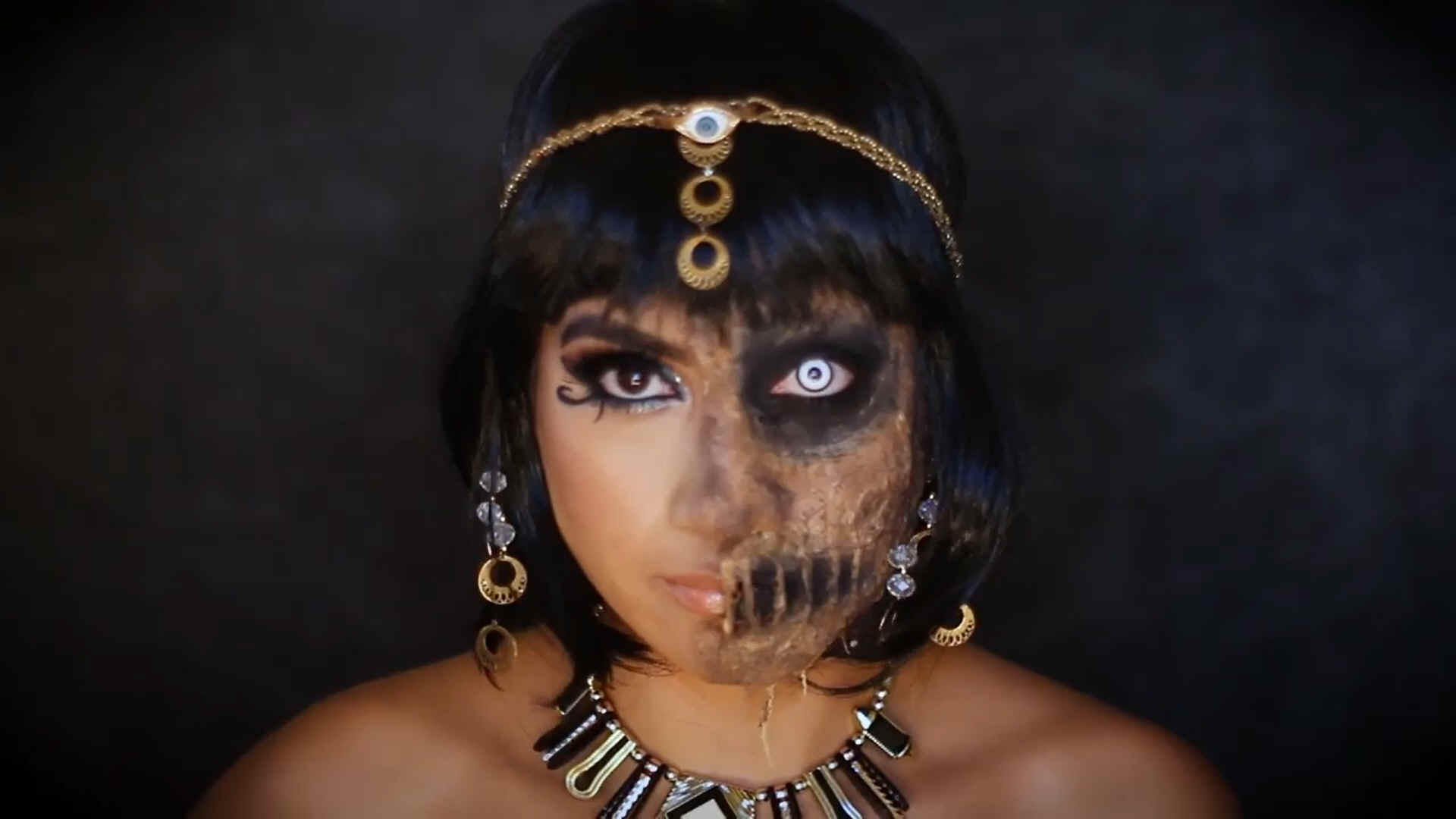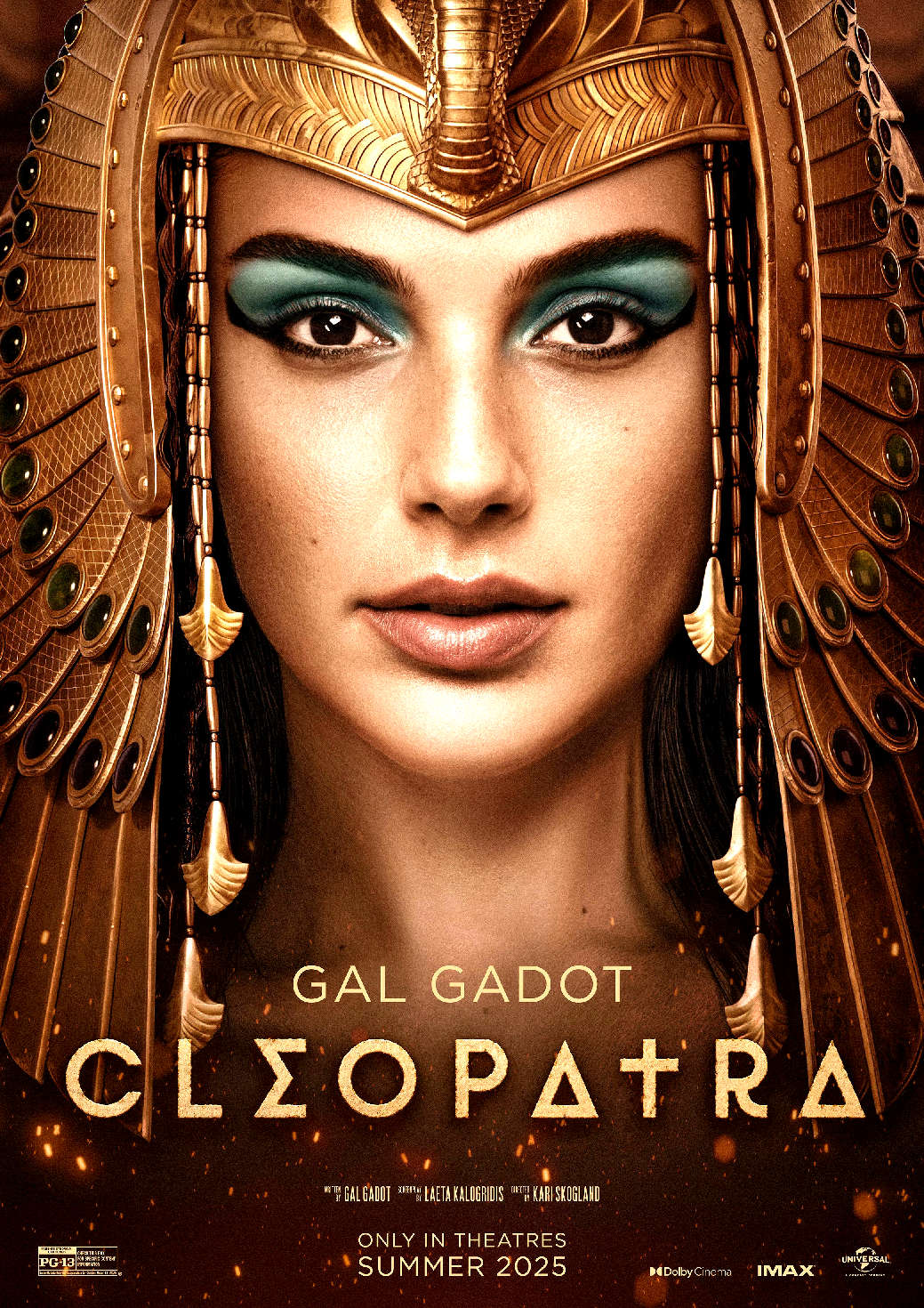
The number of people taking to Youtube to show how to apply makeup to achieve
that Cleopatra
look is mounting. What is also amazing is that they nearly all appear to have high skill
levels in the cosmetic art form. Below are some of the best we have seen,
with our personal favorite at the top, a clever mummy mask on one side of
the face, and superb eye art on the other.
Queenly, and undeniably cool, there's no eye makeup look more famous than
Cleopatra's elongated, blue-and-black cat-eye. But as anyone who's ever tried to wing out their liquid eyeliner can tell you, it's not easy to get one razor-sharp line right, let alone two.
Thesse tutorials show that it can be done. Then you can add a straight black
or plaited wig with gold
bangs to recreate the classic Hollywood version of Cleopatra. How
then, do you create a more historically accurate version of Cleopatra's trademark
look - using modern makeup brands.
Video by Genesis Cervantes (Genie) Business: genesiscervantes.gc@gmail.com
https://www.youtube.com/watch?v=Yo9f3iofeWU
https://www.youtube.com/@genie3309
PRODUCTS USED:
MUMMY SIDE - Liquid Latex, Cotton Balls, Small Bowl to Pour Liquid Latex In,
Urban Decay 24/7 Black Pencil Liner
L'oreal Infallibile Black Gel Liner, Urban Decay Eyeshadow in Blackout, LA Girl Pro Concealer in Toast
CLEOPATRA SIDE - Urban Decay Primer Potion, Makeup Geek Shadows- Peach Smoothie, Cocoa Bear, Cherry Cola
Revlon Eye Art Glitter in Twinkle Topaz, Urban Decay All Nighter Foundation,
NYX Matte Liquid Liner
https://www.youtube.com/watch?v=-VCZt2CkdQc
https://www.youtube.com/@sarahnewsfx
FACE MASKS
Cleopatra was said to have used dead sea mud, clay, and egg whites as facial masks in ancient Egypt, and other cultures followed by natural facial and skin care regimens. Regardless of the ingredients used, all acknowledged the importance of caring for the skin.
Facial masks work by steering ingredients closer and deeper into the skin, infusing the pores, and allowing the skin to soak up more of the ingredients found on the product. They can have the immediate effect that users are looking for, but they may be temporary. Then again, facial masks can give you a glow or boost for an event.
Prior to using a facial mask, be sure to wash your face with warm water and clean it with a gentle cleanser to remove any dirt, makeup, or residue. Using warm water enables the pores to stay open and for the ingredients to seep in the face better.
Ensuring that you get top-quality masks from reputable companies is vital.
BENEFITS OF USING A FACE MASK
Some of the benefits of using facial masks, according to Discover Good Nutrition, include:
- Relaxation: Facial masks don’t just offer results that boost the overall appearance of the skin, but they can also be quite therapeutic. When they are infused with aromatic essential oils like rosemary and mint, a facial mask can lift your spirit by stimulating your senses.
- Deep cleansing: A proper facial mask can help draw out impurities that hide beneath the top layers of the epidermis.
- Unclog pores: Masking with a product that contains Bentonite clay helps absorb excess oils and eliminate dirt as well as the build-up of dead skin cells that accumulate in the skin. Once all of this debris is taken out of the surface of the skin, it will also help unclog pores. This will prevent the production of bacteria from the pores which can lead to breakouts or even pimples.
- Glowing skin: Facial masks, specifically those with tingly mint in the formulation, can help stimulate blood circulation. The process of the mask drying on the skin and starting to harden, followed by the removal of the mask, causes an expansion in the blood vessels in your skin. This ensures an overall enhancement in skin tone.
- Helps your overall regimen: Facial masking helps all of your other skin care products to work more effectively. If you want your serums, day creams, and nighttime products to be absorbed by the skin faster and deeper, then a facial mask is a must.
WHAT TYPES OF FACIAL MASK IS BEST FOR YOU?
These include:
- Cream Masks: Normal to dry skin types will benefit from cream masks, which are rich in moisturizers and oils that penetrate deeply and replenish dry cells.
- Clay Masks: Restorative, moisturizing clay masks that naturally detoxifies skin as it hydrates without oil are a good option for oily and normal skin types. Clay masks are occlusive, meaning they close off the skin to the air, thus causing the brain to send down natural skin plumpers while detoxing, firming, and tightening the skin at the same time.
- Gel Masks: The cooling and soothing effect of gel masks are ideal for dry and sensitive skin types that require hydration ahead of detoxifying and firming. A gel mask is infused with antioxidants and collagen that help these skin types to recover.
- Sheet Masks: Popularized in Korea, although this type of mask works well with all skin types based on the formulas it contains, sheet masks are particularly excellent for resistant skin types when paired with serums.
- Exfoliating Masks: This is ideal for most skin types. However, if you have sensitive skin, it is advised to try enzyme masks. An exfoliating mask purges deep-seated dirt in the pores and sloughs off dulling dead skin cells using fruit enzymes (typically from pineapple and papaya) and hydroxy acids (like lactic and glycolic acids). They also have natural skin-brightening properties or that instant healthy, lit-from-within glow.
Once you find the facial mask that works for you, work it into your skin care regime. It is better to use masks after serum but before moisturizer, or for nighttime masks rather than your nighttime moisturizer.
A good rule of thumb for any facial mask you select, is to avoid ones that contain irritating ingredients like alcohol, eucalyptus, and camphor (natural and synthetic).
HOW OFTEN SHOULD YOU USE A FACIL MASK?
The question as to how often a facial mask should be used depends on several factors, such as:
- Your skin type
- Your age
- The weather
- The time of year
FOR OILY SKIN
A clay mask works well to pull out the oil, but it should only be worn for 15 minutes and no more than three times a week. Clay masks are also more effective if they are not dried completely. Look for ones that feature alpha hydroxy acid (AHA) or hyaluronic acid.
DRY & SENSITIVE SKIN
For this type of skin, hydrating masks are best and should include ceramides and hyaluronic acid, olive oil, aloe (for extra moisture) as well as oatmeal (to de-stress sensitive skin). Do not use face masks more than once a week as they can dry out the skin even more.
MATURE SKIN
Face masks with antioxidants helps fight free radicals and collagen to enhance elasticity. Argan oil and shea butter, on the other hand, can add moisture and help reduce fine lines. Niacinamide is an essential anti-aging ingredient as well. However, if you use an anti-aging mask, be sure to apply it no more than twice a week. More advanced masks, such as the Omnilux mask, provide more noticeable benefits. This type of mask reduces fine lines and wrinkles, as well as promotes skin renewal, with no down time.
WEATHER & SEASON
Skin tends to be dryer in the cold season than in the summer. When it’s cold outside, your cheeks can become chapped and red, and they require more attention. You can safely use a moisturizing mask several times a week during cold climates. In summer, if you’re producing more oil due to the heat, you can apply masks with seaweed but only once a week.
Though it may be tempting, do not overuse your face mask. Follow the instructions placed on the product or seek advice from a professional for proper use of a face mask or if you are allowed to use a face mask at all.
WHY
DID CLEOPATRA WEAR MAKEUP?
Over five thousand years ago, the ancient Egyptians used eye shadow, not only for cosmetic but practical purposes as well. Dark pigment painted around the eye helped protect the eye from the bright midday sun glaring off the desert sands. The earliest eye paint in ancient Egypt was a thick, bright green paste made from the mineral malachite.
By the time Queen Cleopatra came to power in the 1st century BC,
Ancient
Egyptian women had at their disposal a whole rainbow pallete of cosmetics, all of which were made from rocks, minerals, and plants in the region. Cleopatra used the bright green malachite paste of the ancient Egyptians on her lower eyelids.
On her upper eyelids, she used a deep blue eye shadow with gold-colored pyrite flecks, made from ground lapis lazuli stone. She darkened her eyebrows and lengthened her eyelashes with black kohl, a mixture of powdered lead sulfide and animal fat. And for lipstick and rouge,
Cleopatra used red ochre, a type of clay colored red by iron oxide.
The Egyptian queen even wore nail polish, made of the reddish-brown dye called henna, which comes from the Egyptian privet tree. And Cleopatra often had her palms painted with henna in elaborate designs. Like the ancient Egyptians before her,
Cleopatra used her cosmetics not simply for beauty's sake, but for certain benefits that beauty might bring. With
Julius Caesar as her lover and, later,
Marc Antony as her husband,
Cleopatra consolidated Egypt's power with that of Rome.
MARVELOUS MAKEUP
Makeup is marvelous. It can transform your confidence in five minutes, make you feel more ready to face the world and even get rid of skin blemishes that you don’t want anyone to see. Making them all but invisible.
This multi-billion-dollar industry has developed makeup for practically every application you can think of. From making eyes pop with eyeshadow palettes to hiding large pores, makeup has come such a long way. Even vegan makeup is a huge contender in the industry.
To understand the origin of makeup, we must travel back in time about 6,000 years. We get our first glimpse of cosmetics in ancient Egypt, where makeup served as a marker of wealth, believed to appeal to the gods.
If you’ve ever seen Egyptian art, you’ve no doubt noticed the dramatic eye makeup present on men and woman. Ancient Egyptians of both genders routinely wore makeup and other cosmetic aids such as perfume. However, they had to work hard and be very creative by choosing what was available in their surrounding environment.
As early as 4000 B.C., Egyptians used materials in order to design makeup. Some of the common cosmetics in ancient Egypt included malachite, a copper ore, which provided the green eye makeup colour so greatly favoured at the time. Kohl was used to draw thick, distinctive black lines, and red ochre was used as rouge or lipstick. Most of these were ground into powder and then mixed with a carrier agent (often animal fat) in order to make it easy to apply and stay on the skin.
It wasn’t just about appearance and appeasing their gods; both men and women used to use various cosmetics and rubbed them all across their skin to protect it from the drastic atmospheric conditions and the strong sun.
They believed kohl helped fend off various diseases and helped with the glare of the sun. They also believed eyes bare of makeup were vulnerable to the evil eye.
The most obvious way to differentiate the upper classes from the poor was to look at their cosmetics applicators and storage. The poorer relied on sticks and simple clay pots while those with money had beautiful ivory containers and applicators that were carved and
bejeweled. Even the well-off women were often buried with two or more pots of lip paint.
You cannot talk about Egyptian makeup without thinking of Cleopatra, the queen of beauty innovation and a beauty icon to this day. Aspects of her look are still so relevant today and I find this so fascinating. It’s believed she used milk and honey facemasks for their moisturising properties. Her famous milk baths were for rejuvenating the skin and Dead Sea salts were commonly used to exfoliate.
Her eye makeup was dramatic and interesting to say the least. She wore golden-flecked bright blue eyeshadow on top of her eyelids with the popular green paste on her lower lids. Her lips were always very dark red as this showed her extreme importance. The darker the lip the wealthier and more affluent the person.
But she didn’t apply her own makeup. No way. She had a servant who was skilled with cosmetics to do it. The very first makeup artist. Cleopatra would sit in front of a polished bronze “mirror” and this application could take an hour or so.
Imagine then the preparation regime for her hair plaits. About an eighth of every waking day was spent prepararing to look good. No wonder she wowed the men. That, combined with her revealing and scanty clothing.
It’s fair to say the Egyptians have heavily influenced the world in beauty rituals and cosmetics. Mystery still surrounds them, but their beauty tricks are no secret. The strong red lip and heavy kohled eyes will forever be a permanent fabulous fixture in the makeup world. They helped pave the way for this vastly wealthy industry that
is still developing new looks, using sustainable ingredients.

THE SIGNIFICANCE OF KOHL IN ANCIENT
EGYPT
Kohl has been a popular cosmetic in civilisations across the world since prehistoric times, but its association with ancient Egypt is most well-known. We are all familiar with the Egyptians legendary eye-makeup. With Cleopatra as its ‘poster girl’, most famously depicted by Elizabeth Taylor in 1963, the queens signature eye-paint still inspires costumes and makeup looks today. Though the Greeks and Romans also used kohl as an eye-liner, its use in Egypt was much more than simply cosmetic. Used by both men and women of all social classes, the Egyptians believed kohl also had important medicinal, magical and religious qualities.
In the eyes of the Greeks and Romans, excessive adornment belonged only to the prostitutes and favoured more naturalistic makeup, using kohl to finely line the eyes and extend the brow. The Egyptians however shared a different view and smeared kohl over their eyes daily. Wearing both green malachite and black galena in bold designs, kohl exaggerated their eyes to enhance their beauty. Although she was not Egyptian herself, Cleopatra likely followed ancient traditions wearing beautifully elaborate eye looks, perhaps similar to our modern recreations.
To create these eye paints, kohl was ground in a pestle and mortar and mixed with oils or animal fats on palettes to; then the kohl paint was applied to the eyes using a small stick. Galena, replacing malachite, gradually became the predominant ingredient in kohl cosmetics and its use continued through until the Coptic period; the Fayum mummy portraits display less complicated, everyday use of kohl by both men and women during the Roman period, perhaps influenced more by the styles of Roman women which became popular after the first century AD. As well enhancing beauty, the cosmetic use of kohl could also indicate social rank and achievement, perhaps with more complicated designs worn regularly by the elite.

RELIGIOUS & MEDICINAL IMPORTANCE
So important was its use in ancient Egypt that containers of kohl, along with various instruments for its preparation and application, were buried alongside the dead. This clearly shows just how essential kohl was in daily life but also in the afterlife, which indicated that it had important religious functions. Kohl was associated with the deities Horus, Ra and Hathor and was regularly used in ritual. Egyptians also exaggerated their eyes with bold liner in veneration of the gods, as they believed it possessed magical properties in providing protection from diseases and warded off the Evil Eye (Tapsoba et al. 2010, 457; Illes n.d., 2).
Though these magical benefits of kohl may seem irrational to us today, these protective qualities are fully supported by recent studies of the various ingredients found in kohl. Egyptians faced many health issues that effected the eyes; from dust from the desert, to insects and bacteria from the flooding of the Nile, diseases such as conjunctivitis, cataract, trachoma and trichiasis played the population. The proscription of kohl to treat and prevent these illnesses can be found extremely early on in the Ebers papyrus, but were ancient physicians correct to think kohl could heal them?
Kohl contained multiple ingredients that not only added to the beautiful shine of galena, but are also known for their medicinal benefits. Zinc oxide is a powerful natural sunblock, neem has astringent and antibacterial properties and also possesses anti-viral activity like silver-leaf, while fennel and saffron were often used to fight many eye diseases. Other ingredients, such as chaksu and precious gems, were also believed to improve sight (Pak 2009, 110). It has also been discovered that Egyptians synthesised lead compounds (laurionite and phosgenite) to add into their cosmetics, which Dioscorides explains “appear to be good medicine to be put in the eyes” (Dioscorides 5,102).
Although the addition of lead to cosmetics may seem absurd due to its known toxicity, with some pitying the “devastation” kohl must have cause in ancient Egypt, these compounds were not harmful and did actually provide beneficial medicinal roles (Hallmann 2009, 71-2). A biomedical study, which made the news in 2010, ended controversy over the harmful effects of kohl. By analysing various samples found in Egyptian tombs and recreating ancient recipes, reported by Greco-Roman authors, scientists were able to test the effects of these led compounds on skin cells. Amazingly instead of causing lead poisoning, these lead compounds instead triggered an overproduction of nitrogen monoxide, which stimulates nonspecific immunological defences. This data suggests that the daily wearing of kohl made Egyptian eyes almost immediately resistant to bacterial infections due to the spontaneous response of immune cells. Although concerns about the toxicity of lead, overshadowed its benefits, this study proves that the lead compounds found in kohl did in fact serve a significant medicinal function. Tapsoba therefore argues that these compounds were deliberately manufactured and used in cosmetics to prevent and treat eye diseases (Tapsoba et al. 2010, 457-60). Galena and these other lead sulphides also provide protection from
Egypt’s harsh sun by providing a shield from its glare and harmful UV rays (Pak 2009, 109). The addition of these various ingredients to kohl supports the magical protective beliefs of Egyptians and shows an understanding of ancient physicians of the many benefits this cosmetic possessed.
Although kohl was used by the Egyptians to beautify and decorate their eyes, its daily use for religious and medicinal purposes were extremely important. Though the general
population may have attributed kohl’s magical healing powers to the gods, physicians and perhaps even Cleopatra herself, understood that the ingredients they added to their cosmetics were effective medicines. Its use, in various forms, has been important to many cultures throughout history and it remains a popular cosmetic across the world today.


BLACK
& WHITE WASHING - There is no hard and fast rule concerning the
accuracy of ethnic casting in fiction, with black and white actors, all
getting a look in. Black more and more, but it appears not Greek and
Macedonian, who are under represented when it comes to playing Cleopatra.
There is some scope for interpretation, since we do not know who Cleopatra
VII Philopator's mother was - thought to be Bernice. But with no
definitive proof. Where Elizabeth Taylor played Cleopatra,
almost certainly seen as whitewashing
the part, Gal Gardot may be more acceptable, colour wise to many, if not
(perhaps) ethnicity accurate. But then, Ms Gardot and Laeta Kalogridis
(screenplay) Kari Skogland (director) are not making a documentary. They
are making a movie.
According to IMDB their film could be on release in 2025. Fingers crossed,
that all of this controversy does not put them off.
MEDIA
INDEX
BBC
NEWS - NETFLIX CLEOPATRA DOCUDRAMA 10 MAY 2023
BRISBANE
TIMES - RADAR REVEALS POSSIBLE LOCATION CLEOPATRA'S TOMB 2009
BRITISH
MUSEUM - CLEOPATRA,
17 YEAR OLD DAUGHTER OF CANDACE, THEBES
CAMBRIDGE
UNIVERSITY - STUDY
OF ANCIENT EGYPTIAN MUMMY DNA 17 MAY 2017, RELATED TO MIDDLE EAST
CBC
- CLEOPATRA OUTSMARTED EVERYONE, FEBRUARY 2021
CBS
- WHY
SOME EGYPTIANS ARE FUMING OVER NETFLIX'S BLACK CLEOPATRA
DAILY
MAIL - ADELE JAMES BREAK SILENCE AS TO BLACKWASHING CLAIMS MAY 2023
DAILY
MAIL - DEC
9 2024 KATHLENE MARTINEZ SEARCHING 20 YEARS MAKE SIGNIFICANT
FIND
DISCOVERY
MAGAZINE - JUNE
7 2023, WILL WE EVER FIND THE TOMB OF CLEOPATRA?
GREEK
CITY TIMES - ARCHAEOLOGIST CLAIMS TO BE CLOSE TO DISCOVERY OF CLEOPATRA
2021
LIVESCIENCE
- WHERE IS CLEOPATRA'S TOMB/PALACE JULY 2020
NATURE
- STUDY
90 MUMMIES REVEALS ANCESTRY ANCIENT EGYPTIANS: MIDDLE EASTERN JUNE
2017
ROTTEN
TOMATOES - CLEOPATRA
CRITICS, SERIES 1 REVIEWS MAY 2023
SKY
HISTORY - THE
HIDDEN TOMB OF CLEOPATRA MARCH 2023
SKYE
NEVILLE - PLASTIC FREE COMICS, WAITROSE BANS
SMITHSONIAN
- MORE
THAN HISTORIC SEDUCTIONS, REHABILITATED ELIZABETH TAYLOR, HOLLYWOOD ICON:
2010
SPECTATOR
- THE
TROUBLE WITH NETFLIX'S QUEEN CLEOPATRA 29 MAY 2023
STUART
GIBBS - CHARLIE
THORNE & THE CURSE OF CLEOPATRA - SIMON & SCHUSTER
REVIEW 2023
THE
CONVERSATION - WHY
THE DISCOVERY OF CLEOPATRA'S TOMB COULD REWRITE HISTORY 2022
THE
GUARDIAN - NETFLIX, NO NEED FOR WHITE ACTOR 10 MAY 2023
THE
SUN - QUEEN CLEOPATRA'S TOMB, TAPOSIRIS MAGNA 2020
THE
SUN - THE REICH STUFF: GLOBAL HUNT FOR HITLER'S LOST £20 BILLION NAZI GOLD HORDE APRIL 2021
UNDERWATER
PHOTOGRAPHY GUIDE - CLEOPATRA'S SUNKEN PALACE
USA
TODAY - MUSTAFA
WAZIRI, ALEXANDRIA, EGYPTIAN ARCHAEOLOGISTS 2018
YOUTUBERS
- MAKEUP,
CLEOPATRA'S FACE & EYE COSMETICS, MUMMY MASK
YOUTUBERS
- NETFLIX VIDEO COMMENTS MAY 2023
ZAHI
HAWASS - DOCUMENTARY: CLEOPATRA VII PHILOPATOR
https:/
MAKEUP
LIKE A PRO - CLEOPATRA ICON
|




